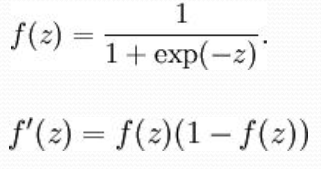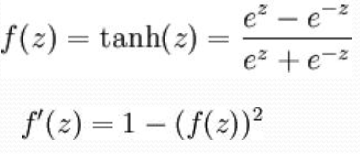統計學習方法邏輯斯蒂迴歸
邏輯斯諦迴歸(logistic regression) 是統計學習中的經典分類方法。 最大熵是概率模型學習的一個準則, 將其推廣到分類問題得到最大熵模型(maximum entropy model) 。邏輯斯諦迴歸模型與最大熵模型都屬於對數線性模型。本文只介紹邏輯斯諦迴歸。
設X是連續隨機變數, X服從Logistic distribution,
分佈函式:
密度函式:
μ為位置引數, γ大於0為形狀引數, (μ,1/2)中心對稱

Sigmoid:


雙曲正切函式(tanh):

二項邏輯斯蒂迴歸
Binomial logistic regression model
由條件概率P(Y|X)表示的分類模型
形式化為logistic distribution
X取實數, Y取值1,0
事件的機率odds: 事件發生與事件不發生的概率之比為 稱為事件的發生比(the odds of experiencing an event),
稱為事件的發生比(the odds of experiencing an event),
對數機率:
對邏輯斯蒂迴歸:
似然函式
logistic分類器是由一組權值係數組成的, 最關鍵的問題就是如何獲取這組權值, 通過極大似然函式估計獲得, 並且
Y~f(x;w)
似然函式是統計模型中引數的函式。 給定輸出x時, 關於引數θ的似然函式L(θ|x)(在數值上) 等於給定引數θ後變數X的概率: L(θ|x)=P(X=x|θ)
似然函式的重要性不是它的取值, 而是當引數變化時概率密度函式到底是變大還是變小。
極大似然函式: 似然函式取得最大值表示相應的引數能夠使得統計模型最為合理
那麼對於上述m個觀測事件, 設
其聯合概率密度函式, 即似然函式為:

目標: 求出使這一似然函式的值最大的引數估, w1,w2,…,wn,使得L(w)取得 最大值。
對L(w)取對數。
對數似然函式
對L(w)求極大值, 得到w的估計值。
通常採用梯度下降法及擬牛頓法, 學到的模型:
直接上程式碼吧,w的極大值採用梯度下降法,用的iris的資料集:
import numpy as np import matplotlib.pyplot as plt from sklearn.datasets import load_iris class LogisticsRegression: def __init__(self): """初始化Logistics Regression模型""" self.coef_ = None self.intercept_ = None self._theta = None def _sigmoid(self, t): return 1. / (1. + np.exp(-t)) def accuracy_score(self, y_true, y_predict): """計算y_true和y_predict之間的準確率""" assert len(y_true) == len(y_predict), \ "the size of y_true must be equal to the size of y_predict" return np.sum(y_true == y_predict) / len(y_true) def fit(self, X_train, y_train, eta=0.01, n_iters=1e4): """根據訓練資料集X_train, y_train, 使用梯度下降法訓練Logistics Regression模型""" assert X_train.shape[0] == y_train.shape[0], \ "the size of X_train must be equal to the size of y_train" def J(theta, X_b, y): ''' 損失函式 ''' y_hat = self._sigmoid(X_b.dot(theta)) try: return np.sum(y*np.log(y_hat) + (1-y)*np.log(1 - y_hat)) / len(y) except: return float('inf') def dJ(theta, X_b, y): ''' 求梯度 ''' return X_b.T.dot(self._sigmoid(X_b.dot(theta)) - y) / len(X_b) def gradient_descent(X_b, y, initial_theta, eta, n_iters=1e4, epsilon=1e-8): ''' 梯度下降 ''' theta = initial_theta cur_iter = 0 while cur_iter < n_iters: gradient = dJ(theta, X_b, y) last_theta = theta theta = theta - eta * gradient if (abs(J(theta, X_b, y) - J(last_theta, X_b, y)) < epsilon): break cur_iter += 1 return theta X_b = np.hstack([np.ones((len(X_train), 1)), X_train]) initial_theta = np.zeros(X_b.shape[1]) self._theta = gradient_descent(X_b, y_train, initial_theta, eta, n_iters) self.intercept_ = self._theta[0] self.coef_ = self._theta[1:] return self def predict_proba(self, X_predict): """給定待預測資料集X_predict,返回表示X_predict的結果概率向量""" assert self.intercept_ is not None and self.coef_ is not None, \ "must fit before predict!" assert X_predict.shape[1] == len(self.coef_), \ "the feature number of X_predict must be equal to X_train" X_b = np.hstack([np.ones((len(X_predict), 1)), X_predict]) return self._sigmoid(X_b.dot(self._theta)) def predict(self, X_predict): """給定待預測資料集X_predict,返回表示X_predict的結果向量""" assert self.intercept_ is not None and self.coef_ is not None, \ "must fit before predict!" assert X_predict.shape[1] == len(self.coef_), \ "the feature number of X_predict must be equal to X_train" proba = self.predict_proba(X_predict) return np.array(proba>=0.5, dtype = 'int') def score(self, X_test, y_test): """根據測試資料集 X_test 和 y_test 確定當前模型的準確度""" y_predict = self.predict(X_test) return self.accuracy_score(y_test, y_predict) def __repr__(self): return "LogisticsRegression()" iris = load_iris() X = iris.data y = iris.target # 二項LogisticsRegression只適用二分類 X = X[y<2, :2] y = y[y<2] # # 畫出資料 # plt.scatter(X[y == 0, 0], X[y == 0, 1], color="red") # plt.scatter(X[y == 1, 0], X[y == 1, 1], color="blue") # plt.show() def train_test_split(X, y, test_ratio=0.2, seed=None): """將資料 X 和 y 按照test_ratio分割成X_train, X_test, y_train, y_test""" assert X.shape[0] == y.shape[0], \ "the size of X must be equal to the size of y" assert 0.0 <= test_ratio <= 1.0, \ "test_ration must be valid" if seed: np.random.seed(seed) shuffled_indexes = np.random.permutation(len(X)) test_size = int(len(X) * test_ratio) test_indexes = shuffled_indexes[:test_size] train_indexes = shuffled_indexes[test_size:] X_train = X[train_indexes] y_train = y[train_indexes] X_test = X[test_indexes] y_test = y[test_indexes] return X_train, X_test, y_train, y_test X_train, X_test, y_train, y_test = train_test_split(X, y, seed = 888) log_reg = LogisticsRegression() log_reg.fit(X_train, y_train) print('測試集預測準確率:'+ str(log_reg.score(X_test, y_test))) print('測試集合預測概率:'+ str(log_reg.predict_proba(X_test))) print('測試集合標籤:'+ str(y_test)) print('測試集合預測標籤:' + str(log_reg.predict(X_test)))
結果:

多項logistic迴歸
設Y的取值集合為![]()
多項logistic迴歸模型
